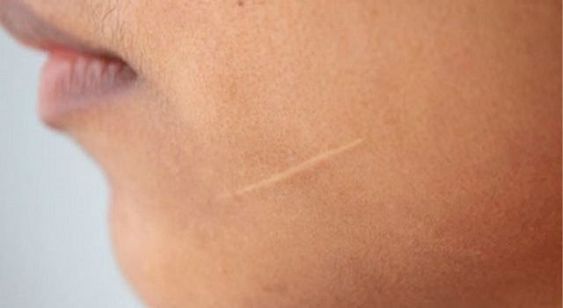Scars, as a mark after wound healing, have various types. Below, we'll take a closer look at the four common types of scars and how to properly manage them when they appear on the face.
1. Understand scar types:
Superficial scars: The color of these scars is often close to normal skin color, and sometimes may be slightly pale. They do not protrude significantly from the surface of the skin but may widen over time.
Hypertrophic scars: These scars are usually significantly higher than the surface of the skin. They are reddish in color and hard in texture and often cause itching.
Atrophic scars: This kind of scar usually takes 3-6 months or even longer to gradually shrink after the proliferative period. Once stabilized, they may become depigmented and prone to ulceration from touch. In some cases, long-term skin breakdown may even lead to scarring and cancer.
Keloid: This is a very special type of scar. Its proliferation range often exceeds the original injury range, showing tumor-like growth, which is clinically called keloid. This type of scar is often more painful and itchy.
2. How to care for scars?
Cleaning the wound is crucial. After facial injury, the wound should be washed with cold boiled water immediately. If it is a burn, the local area should be rinsed with plenty of clean cold water immediately to reduce high-temperature damage to deep tissues and prevent the formation of traumatic scars.
Preventing infection is key to avoiding scarring from wounds. Because the infection will destroy the deep dermal tissue, the epidermis cannot regenerate, eventually leading to the proliferation of granulation tissue and scar formation. To prevent infection, we can apply chlortetracycline eye ointment on the clean wound twice a day until the wound scabs. But remember, do not use iodine for disinfection to avoid causing pigmentation.
When the wound's skin scabs, it will itch. At this time, we should not be impatient or tear off the scabs with our hands. We should let them fall off naturally. Otherwise, the new tissue under the scab may be torn, causing permanent pigmentation spots.
For the repair of facial scars, physical methods are. The main scar reduction mechanism of silicone gel scar dressing is that the high-purity medical silicone component inhibits the proliferation of fibroblasts and capillaries, thereby inhibiting the formation of scars and diluting the color of scars.
Scar care tips:
We should protect the red and tender skin after the scabs fall off and avoid direct sunlight. At the same time, you also need to pay attention to your diet. If you drink a lot of alcohol or consume spicy foods such as pepper, mutton, garlic, ginger, and coffee after an injury, it may stimulate scar hyperplasia. Therefore, we should eat more foods rich in vitamins C, and E and essential amino acids, such as fruits, green leafy vegetables, eggs, lean meat, etc., to help the skin recover as soon as possible.
For more information on Innomed®Silicone Scar Dressing, Refer to the Previous Articles. If you have customized needs, you are welcome to contact us; You Wholeheartedly. At longterm medical, we transform this data by Innovating and Developing Products that Make Life Life easier for those who need loving care.
Editor: kiki Jia

 English
English عربى
عربى Español
Español русский
русский 中文简体
中文简体








